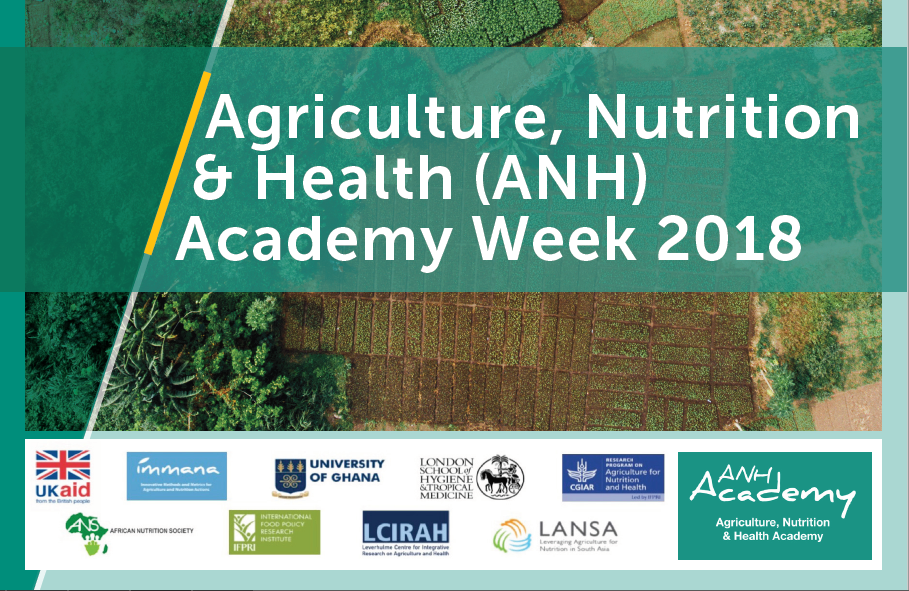
Seven sub-sessions
Chair: Daniel Sarpong, School of Agriculture
Speakers and presentations
Alejandro Ortega-Beltran, International Institute for Tropical Agriculture (IITA)
The Aflasafe Initiative: Mitigating Aflatoxin Contamination of Maize and Groundnut Using Atoxigenic Strains of Aspergillus Flavus as Biocontrol Agents
Recording
Silvia Alonso (on behalf of Delia Grace), International Livestock Reseach Institute (ILRI)
Food Safety Capacity Building in Africa: Current Efforts, Future Prospects
Recording
Godfrey Magoke, University of Sydney/Tanzania Veterinary Laboratory Agency
Aflatoxin Contamination of Village Grains in Central Tanzania: Food and Agricultural Practices in Relation to Contamination and Exposure Risk
Recording
Jef Leroy, IFPRI
The Impact of Reducing Dietary Aflatoxin Exposure on Child Linear Growth in Kenya: A Cluster Randomized Controlled Trial
Recording
Kareem Daari, University for Development Studies
Assessment of the Microbiological Safety of Fermented Milk (Nunu) in Northern Ghana and the Influence of Hygiene Training
Recording
Murielle Farrelle Soglo
The Rapid Degradation of Lambda-Cyhalothrin Makes Treated Vegetables Relatively Safe for Consumption
Recording
Simon Ndungu Nyokabi, Wageningen University,
Assessment of Milk Quality in Smallholder Dairy Systems in Kenya and the Impact of Social Networks on Stakeholders Behaviours and Practices in the Dairy Value Chain
Recording
Q&A
Recording 1 / Recording 2
The Aflasafe Initiative: Mitigating Aflatoxin Contamination of Maize and Groundnut Using Atoxigenic Strains of Aspergillus Flavus as Biocontrol Agents
Alejandro Ortega-Beltran, International Institute for Tropical Agriculture (IITA)
Introduction
Aflatoxin contamination of staple crops is frequent across sub-Saharan Africa (SSA). This negatively impacts health, food security, and trade sectors, and affects farmers, traders, markets, and consumers. Several Aspergillus species produce aflatoxins. However, certain Aspergillus flavus genotypes do not produce aflatoxins (atoxigenic) due to defects in the aflatoxin gene cluster. Atoxigenic genotypes used as active ingredients in biocontrol products efficiently reduce crop aflatoxin contamination from field to plate (up to 100 percent).
Methods
An environmentally friendly aflatoxin biocontrol technology was developed in the United States, where almost a million acres of susceptible crops are treated annually. The technology has been improved for use in SSA under the tradename Aflasafe. IITA, USDA-ARS and national partners have developed several Aflasafe products. To date, products are registered in Nigeria, Kenya, Senegal, The Gambia, and Burkina Faso. Efforts are underway to develop and register Aflasafe products in other SSA nations. In parallel, state of the art technology has been developed for large-scale manufacturing of Aflasafe. Since 2013, The AgResults Aflasafe project, funded by the Bill & Melinda Gates Foundation (BMGF) and the Governments of Australia, Canada, United Kingdom, and the United States, began to incentivize agri-businesses to promote adoption of Aflasafe in Nigeria.
Findings and Interpretations
With a single application of 10 kg/ha, all Aflasafe products, registered and under experimental use, reduce aflatoxin concentrations in treated crops by >80 percent compared to untreated crops in both field and storage conditions. The technology consistently and efficiently reduces crop contamination to safe levels. This has sparked interest to commercialize Aflasafe products and treated crops. IITA is currently identifying key partners for production, commercialization, and use of Aflasafe at scale in 11 countries as a part of the Aflasafe Technology Transfer and Commercialization project, funded by USAID and BMGF. Large-scale use of Aflasafe is resulting in production of safe and nutritious crops and this allows farmers to reach aflatoxin-conscious premium markets.
Conclusions
Based on effectiveness of biocontrol technologies, use of atoxigenic strains to displace toxigenic fungi should be the central component of a comprehensive management strategy, which must include all available practices in the target nation/area. The strategy must include sensitization, training, institutional (e.g. inclusion of aflatoxins in national health and agricultural agendas, development of aflatoxin-conscious markets), and policy (e.g. disposal systems, testing facilities) actions. Only a holistic aflatoxin management system approach will result in reduced food insecurity, decreased health disorders, increased productivity, and increased income and trade.
Food Safety Capacity Building in Africa: Current Efforts, Future Prospects
Silvia Alonso (on behalf of Delia Grace), International Livestock Reseach Institute (ILRI)
Introduction
Food safety is a fundamental social value and challenge worldwide, substantially affecting public health, food security and the productivity of the population. Recent findings from the World Health Organization suggest the burden of foodborne disease is comparable to that of malaria, HIV-AIDS or tuberculosis. The heaviest burden falls on children and sub-Saharan Africa has the highest per capita burden. The food safety landscape and challenges in sub-Saharan Africa are complex and diverse. We present findings from a recent study with the objective of providing data, analysis and recommendations to improve and coordinate food safety capacity building in Africa.
Methods
The project mapped and analyzed the initiatives, projects and resources devoted to food safety capacity building in Africa by a wide range of public organizations, including multilateral development organizations, such as the World Bank, the UN agencies, and the STDF; major bilateral donor agencies in the United States, Europe, and Japan; the African Union, the African Development Bank, and the African regional economic communities. Major food industry capacity building initiatives were noted. Discussions and in-depth interviews were held with food safety experts and stakeholders in east, west and southern Africa as well as those from Europe and the United States with extensive knowledge of food safety in Africa. A symposium with lead private sector actors was held in Kenya. A conceptual framework was developed based on risk analysis and the Paris Declaration and this was used to organize and analyse the results
Findings and Interpretations
We identified global, regional and national governance institutions involved in food safety in Africa. We also listed donors and food industry actors with an interest in African food safety. We used this information to populate a database of projects on food safety between 2010 and 2017. This contains over 500 projects organized by various criteria. Key findings include: the small number of donors responsible for the great majority of food safety projects; the consistently different interests of donors; the poor relation between donor projects and domestic health burden; the tendency of projects to be driven by external rather than African concerns; the growing interest in food safety and the broadening of approaches to investment. We present a quantitative and qualitative synthesis of the findings.
The questionnaire survey and private sector symposium confirmed these salient features and raised additional issues. These included: the focus on outputs rather than outcomes and impacts; the focus on farm and value chain rather than consumer; the challenges of regulation including fragmentation, unclear mandates and low governance; the need for different and specific approaches to support the formal and informal sector; the relative neglect of gender and equity in food safety projects.
Conclusions
We conclude there is massive under-investment in food safety, and current investments are not well-adapted to reducing the burden of foodborne disease. We develop recommendations that address: 1) goals and strategy, 2) implementing framework and mechanisms, and 3) possible approaches to strengthen capacity building in the formal and informal sectors of the African food system. Given the focus of this report on donor community capacity building efforts, they apply primarily to donors and national governments, but in most cases the recommendations entail consultation and involvement with the private sector and a wide range of civil society organizations.
Aflatoxin Contamination of Village Grains in Central Tanzania: Food and Agricultural Practices in Relation to Contamination and Exposure Risk
Godfrey Magoke, University of Sydney/Tanzania Veterinary Laboratory Agency
Introduction
Food contamination with aflatoxins is a serious threat to human health worldwide, particularly in sub-Saharan Africa. Aflatoxins are toxic and carcinogenic fungal metabolites or mycotoxins produced mainly by Aspergillus flavus and A. parasiticus on a variety of crops, foods and feeds. Maize and groundnuts are major dietary staples in sub-Saharan Africa and are frequently contaminated with significant quantities of aflatoxins. Aflatoxins may cause severe acute hepatotoxicity and even death, liver cancer in adults, reduced growth rates in children, increased risk of infection, as well as reduced productivity and death of livestock.
Methods
The aims of this project were to 1) explore food practices that may be associated with increased risk of aflatoxin contamination of village grains and exposure of villagers and 2) determine the degree of contamination of various village grains. Our study area was eight villages from two wards in a semi-arid Manyoni District, Central Tanzania. In Majiri ward, the villages were Kinangali, Majiri, Mpandagani and Mahaka, and in Sanza ward, the villages were Sanza, Ntope, Chicheho and Ikasi. Adults (55 women, 21 men) were interviewed using a structured questionnaire to collect information on activities related to food production by village farmers, including crop cultivation, harvest, storage, food processing and knowledge of food toxins. Random and convenience sampling strategies were employed to obtain and enroll participants. Samples of village grains were randomly collected immediately post-harvest (n=134) and during storage (157). Samples were screened by ELISA (AflaCHECK, Vicam) and those containing ≥10 µg/kg aflatoxins, were quantified using HPLC-FLD after immunoaffinity column clean-up. The Tanzania maximum tolerable level (MTL) for total aflatoxins is 10 µg/kg. The respective number of new and stored grain samples were: maize (35, 47), groundnuts (39, 17), sorghum (24, 41), sesame (11, 23), sunflower (9, 10), bulrush millet (6, 7), rice (6, 8), and green gram (4, 4).
Findings and Interpretations
The following practices and factors were identified as increasing the risk of aflatoxin exposure: lack of irrigation, fertilizer, and insecticide use on grain crops; prolonged sun-drying of harvested crops; drying over exposed surfaces; reliance on sensory means to determine grain dryness; house storage and storage in polythene bags; lack of use of storage insecticides; in-storage grain damage by insects and vermin; consumption of non-refined grain based foods; and lack of knowledge of aflatoxins and limited extension services. Total aflatoxin concentration was significantly higher in maize and groundnut ranging up to 192 µg/kg and 198 µg/kg respectively, in immediate post-harvest grain samples and up to 213µg/kg and 351µg/kg respectively, in stored grain samples. In addition, two stored sunflower seed samples were found to contain a significant (164µg/kg and 171µg/kg) concentration. We could note a concentration of 10.45 µg/kg in a single stored green gram sample. The overall mean aflatoxin concentration was lower (25.46 µg/kg) in immediate post-harvest grain samples compared to stored grain samples (50. 83µg/kg).
Conclusions
Village grains for human consumption in central Tanzania, particularly maize and groundnuts, may be contaminated with high concentrations of aflatoxins that can pose significant health risk. Existing agricultural and food practices as well as lack of knowledge on aflatoxins may assist aflatoxin contamination of grains as well as human exposure. Therefore, village farmers would benefit from better extension services, using livestock manure as fertilizer, being assisted with drought tolerant seeds as well as better grain drying and storage technologies to achieve optimal and safe food production.
The Impact of Reducing Dietary Aflatoxin Exposure on Child Linear Growth in Kenya: A Cluster Randomized Controlled Trial
Jef Leroy, IFPRI
Introduction
Aflatoxins (AFs) are a group of naturally occurring mycotoxins that pose important health risks. AFB1, the type of AF produced by A. flavus and A. parasiticus can lead to death from aflatoxicosis when consumed in high doses and is a potent carcinogen. Observational studies have shown an association between AFB1 exposure and reduced linear growth in utero and in infants and young children; an inherent limitation of these observational studies is that they cannot fully exclude confounding.
Methods
The study was conducted in rural areas within Meru and Tharaka-Nithi counties in Kenya, an area where maize is the predominant crop and frequent aflatoxicosis outbreaks and widespread contamination of maize have been reported. A cluster randomized controlled design assessed the effectiveness of reducing aflatoxin exposure on child linear growth and serum aflatoxin levels. The intervention consisted of a swapping (contaminated maize was replaced with safe maize) and a stockist component (households were encouraged to purchase from a stockist supplied with clean maize). Women in the fifth to final month of pregnancy were invited to enroll in the study. Outcomes were child length-for-age Z-score (LAZ), the prevalence of stunting, and child serum AFB1-lysine adduct level 24 (endline, primary outcomes) and 16 months (midline, secondary outcomes) after trial commencement, respectively. Ordinary least squares regression analysis was used to estimate the impact of the intervention. We estimated models that controlled for pre-specified baseline covariates, and reduced models (retaining only the statistically significant socio-economic covariates). Sensitivity analyses were conducted to assess the importance of observations lost to follow-up. In addition, we used multiple imputation to fill in missing values. The standard errors were adjusted clustering.
Findings and Interpretations
Of the 1,230 unborn children enrolled in the study, 881 (72%) were included in the LAZ and 798 (65%) in the serum AFB1 analysis. Children were on average around 22 months old at endline and four out of 10 were stunted. AFB1-lysine adduct was detectable in all analyzed serum samples with a mean serum level of 18.1 pg /mg albumin (median 6.1 pg /mg albumin). The intervention significantly reduced ln serum AFB1-lysine adduct levels at endline (intervention effect -0.273, 95% CI -0.547 to 0.001; one-sided p= 0.025) but had no effect on child LAZ or on the prevalence of stunting at endline. At midline, the intervention increased LAZ by 0.16 (95% CI -0.009 to 0.33; one-sided p=0.032) and reduced the prevalence of stunting by 7 percentage points (95% CI -0.125 to -0.007; one-sided p=0.015) but had no impact on serum AFB1 levels. The sensitivity analyses (reduced model, model including the predicted log-odds of dropout, multiple imputation) did not change any of the findings.
Conclusions
This study, carried out in eastern Kenya, is the first cluster-randomized controlled trial to test whether aflatoxin exposure stunts child linear growth. The intervention significantly lowered serum aflatoxin levels: at endline, children in treatment communities had serum aflatoxin levels that were 27 percent lower than in the control communities. The intervention, however, did not improve child linear growth. The midline growth effect (secondary outcome) leads to important questions regarding the timing of toxicity of aflatoxin for growth. The intervention appears to have had a large positive growth effect when children were on average between 13 and 14 months old, but this growth effect was no longer observed in the same children at endline. This suggests that the toxic effect of aflatoxins might vary by age. Future studies should explore these age-varying effects. Even if future studies find no effect of aflatoxin on linear growth, research should focus on better understanding the (hypothesized) effects of aflatoxin exposure on environmental enteric dysfunction, systemic inflammation, immunomodulation, and changes in the hepatic metabolism of micronutrients. Several of these pathways are likely to affect other critical outcomes, such as child health and development.
Assessment of the Microbiological Safety of Fermented Milk (Nunu) in Northern Ghana and the Influence of Hygiene Training
Kareem Daari, University for Development Studies
Introduction
In some low- and middle-income countries (LMICs) fermented milk products are used in complementary feeding of young children, but research in Ghana by Omore et al. (2009) found that many ready-to-consume dairy products including fermented milk (nunu) failed to meet quality standards for faecal coliforms, indicating poor hygiene during milk collection and processing. Consequently, DFID-funded training was carried out on personal hygiene and good manufacturing practices for producers of dairy products in northern Ghana in 2012. This study aimed to assess the presence of coliforms and other pathogenic bacteria in nunu, and whether training influenced the findings.
Methods
Ten trained and 10 untrained nunu producers were recruited randomly from a large volunteer group. Samples of nunu were collected from each producer at designated venues, days, and dates agreed and fixed by researcher and producers. Repeat samples were collected from each one week apart during June 2015. Samples were collected into sterile Stomacher Circular 400 Standard bags (BA6141; Seward West Sussex, United Kingdom) and immediately packed on dry ice in an ice chest and transported to the Animal Research Institute Laboratories in Accra, Ghana by air. The samples were stored in the laboratories at -20 ºC in deep freezers until a microbiological safety assessment by culture and non-culture methods. Denaturing Gel Gradient Electrophoresis (DGGE) and Next Generation Sequencing of the bacterial 16S rRNA was used to assess the full bacterial composition of 10 out of 40 samples from which DNA had been extracted. Producers were also interviewed using a semi-structured questionnaire to establish how they routinely prepared and stored nunu and to assess adherence to the DFID-funded training recommendations. The training was on personal hygiene and good manufacturing practice to avoid the public health risk of pathogenic organisms especially coliforms in fermented milk products.
Findings and Interpretations
Between half to three-quarters of all samples from both trained and untrained milk processors contained coliforms including E. coli. There was no significant difference in the presence of coliform bacteria, including E. coli, in samples from trained producers (75%) compared with untrained producers (50%) p=0.102. Adherence to training recommendations was poor. Common practices by both trained and untrained producers of nunu include use of unpasteurised milk, no cooling/refrigeration of milk during handling or processing of fermented milk, milk was not cooled or refrigerated during handling and/or processing, use of plastic containers and calabashes, and starter cultures were not used. Results from the sequence analysis and DGGE indicate that although the most prevalent bacteria in nunu were streptococci, there was also a relatively high abundance (often exceeding 10% of total bacterial content) of other potential pathogens e.g. E.coli or Shigella species and Enterobacter were prevalent comprising more than 10 percent of the total bacteria identified in 7/10 samples and E.coli or Shigella species comprised more than 10 percent of total bacteria present in 4/10 samples analysed. The current training methods do not therefore alleviate the problem of bacterial contamination, illustrated by minimal difference in bacterial contamination of samples from trained versus untrained producers.
Conclusions
Coliforms and other pathogens were common in the nunu samples and there was no evidence of an effect of training on the presence of pathogens. To meet these challenges, alternative methods such as the Lactoperoxidase Milk Preservation System may be used in place of refrigeration or the adoption of the Village Milk System involving pasteurisation and packaging of fermented milk products. It is also important to consider using probiotic starter cultures in the processing of fermented milk products. It has been suggested that fermented milk in complementary feeding for the prevention of anaemia could be an innovative theme to focus and there is some limited evidence of the potential of using probiotics to promote child growth. Therefore, an alternative strategy could be the promotion of the production of ‘probiotic fermented milk products’ using novel bacteria starter culture of Lactobacillus rhamnosus yoba 2012 and Streptococcus thermophilus C 106. Provision of training methods which can be readily adhered to by predominantly rural producers, and monitored compliance is essential if these products are to be produced in a safe form, especially for complementary feeding.
The Rapid Degradation of Lambda-Cyhalothrin Makes Treated Vegetables Relatively Safe for Consumption
Murielle Farrelle Soglo
Introduction
Lambda-cyhalothrin (λ-cyhalothrin) is the most used pyrethroid insecticide for vegetable farming in Benin. This insecticide is misused and overused by farmers, and hence may pose health hazards to consumers.
Methods
We monitored λ-cyhalothrin residues in lettuce and cabbage from farms to market gates in Cotonou and Parakou using High Performance Liquid Chromatography (HPLC) analysis techniques. Lettuce samples were collected from Houeyiho farms located in Cotonou and many other sales collection points within the same town. Similarly, cabbage samples were collected from Bawera vegetable farm in Parakou and also in identified vegetable sales points within this same town. Collected samples of lettuce and cabbage were taken to the laboratory and analysed for λ-cyhalothrin residues using HPLC. On-farm sampling for monitoring the presence of insecticide residues on the two vegetables was conducted a day after insecticide treatment (D1), subsequently, sampling was conducted every three days until the 14th day.
Findings and Interpretations
Results revealed that λ-cyhalothrin residues in lettuce from Houeyiho reduced from 4.2 mg/kg on Day 1 to about 0.2mg/kg on Day 7. On Day 9, analysed lettuces were all λ-cyhalothrin free. In contrast, even 14-days post treatments of cabbage from Bawera (Parakou), still recorded presence of λ-cyhalothrin residues in analysed samples. For samples from market gates, λ-cyhalothrin residues were found in lettuce from two markets out of the nine surveyed in Cotonou. Interestingly, none of these contaminated samples had residues above the Maximum Residue Limit (MRL=0.5 mg/kg). Similarly, at Parakou, samples from all five surveyed vegetable markets were contaminated with λ-cyhalothrin residues at concentrations below MRL (MRL=0.2 mg/kg).
Conclusions
We conclude that λ-cyhalothrin residues in lettuce and cabbage from farms and markets in Parakou and Cotonou are within the MRL hence, are relatively safe for consumption.
Assessment of Milk Quality in Smallholder Dairy Systems in Kenya and the Impact of Social Networks on Stakeholders Behaviours and Practices in the Dairy Value Chain
Simon Ndungu Nyokabi, Wageningen University
Introduction
The dairy sector plays an important role in the Kenyan economy. Farmers are becoming more market-oriented in their production strategies, yet the quality of the raw milk reaching the market is not improving. In the absence of appropriate market governance, and institutions capable of ensuring that milk is produced to the quality standards required by the dairy industry, poor quality milk has become a bottleneck to development of the formal value chain, and the growth and expansion of the vibrant and dynamic dairy sector in Kenya, undermining its ability to access profitable higher-end markets, within and beyond its national borders.
Methods
This study was carried out in Nakuru Nyandarua and Laikipia counties in Kenya. This research was conducted using a multidisciplinary, mixed methods approach and farms were sampled using a spatial framework that considers market quality and takes into account urban and peri-urban locations (PUL), mid-rural locations (MRL), and extreme rural locations (ERL). Sampling sites were randomly selected using Grass software to capture spatial distribution. Milk was sampled along different nodes of the formal and informal value chains and analysis for composition and somatic cell count using Ekomilk analyser and Ekomilk somatic cell counter. Culturing of bacteria using MacConkey agar and blood agar was done to test for microbial contamination. Finally, a milk ring test for brucellosis was undertaken. Social network analysis (SNA) of dairy value chain was conducted using a Net-Map exercise to map the value chain, actors’ interactions and the impact of this interactions on milk quality. Stakeholder meetings were organized for each county and participatory mapping done with the actors representing the various groups in the value chain. Perceptions of power and influence, milk quality challenges, and opportunities for improvement elicited during the discussions. Netmaps were redrawn using Visualyzer software and transcripts of the discussions analysed using Atlas.ti.
Findings and Interpretations
Results show that milk composition varies according to locations. The mean protein content was slightly below the standard in PUL and ERL while it was slightly above the standard for MRL. Mean freezing points were below the standard range in all locations while the other values were acceptable. When compared based on counties, only Nyandarua satisfied the protein content requirement while the mean freezing points were below the standard range in all counties. There was high microbial contamination of raw milk especially with Pseudomonas spp and E. coli due to poor handing of raw milk, lack of testing of milk quality, poor infrastructure in rural areas, the lack of an economic incentive and contractual obligations for smallholder farmers to produce high quality milk. Netmap results show farmers, processors, and cooperatives are the core actors in the value chain. There are low levels of vertical and horizontal integration in the informal Value Chain and it is not fully entrenched in the formal value chains. Contacts guiding transactions and specifying product quality were absent as was economic incentive to improve milk quality. Poor milk prices, poor infrastructure and low access to information contributes to poor food safety performance in the dairy industry.
Conclusions
There is need for concerted efforts to improve milk quality through increased milk testing by the industry, bridging of information asymmetries, and establishment of quality management systems to enforce quality control and food safety standards. The various physicochemical composition of milk determines the end product that can be produced by processors. The low protein levels have implication on processing and also fall below the nutritional standards set by the government. The high levels of milk contamination evidenced in this study may expose consumers to public health risks. The findings of this study highlight the need to create an enabling policy environment both in national and county governments to foster growth of the dairy sector through improved milk quality. The governance challenges facing the various government institutions need to be addressed to enable them to implement and enforce policies. There is need for the government to invest in critical infrastructure important to dairy sector such as roads, extension services and testing facilities and equipment as a way of improving milk quality. Milk quality is constrained by information asymmetry which is essential towards improving stakeholders’ knowledge and hygienic practices.





